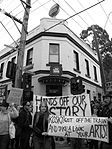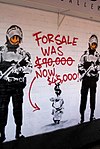Collingwood, Victoria

Collingwood is an inner-city suburb of Melbourne, Australia, 3 km north-east of Melbourne's central business district. Its local government area is the City of Yarra. At the 2016 Australian Census, Collingwood had a population of 8,513.Collingwood is one of the oldest suburbs in Melbourne and is bordered by Smith Street, Alexandra Parade, Hoddle Street and Victoria Parade. Collingwood is notable for its historical buildings, with many nineteenth century dwellings, shops and factories still in use. Its major thoroughfare Smith Street is one of Melbourne's major nightlife and retail strips. It was named in 1842 after Baron Collingwood or an early hotel which bore his name.
Excerpt from the Wikipedia article Collingwood, Victoria (License: CC BY-SA 3.0, Authors, Images).Collingwood, Victoria
Vere Street, Melbourne Collingwood
Geographical coordinates (GPS) Address Nearby Places Show on map
Geographical coordinates (GPS)
| Latitude | Longitude |
|---|---|
| N -37.8019 ° | E 144.98815 ° |
Address
Vere Street 9-11
3066 Melbourne, Collingwood
Victoria, Australia
Open on Google Maps











